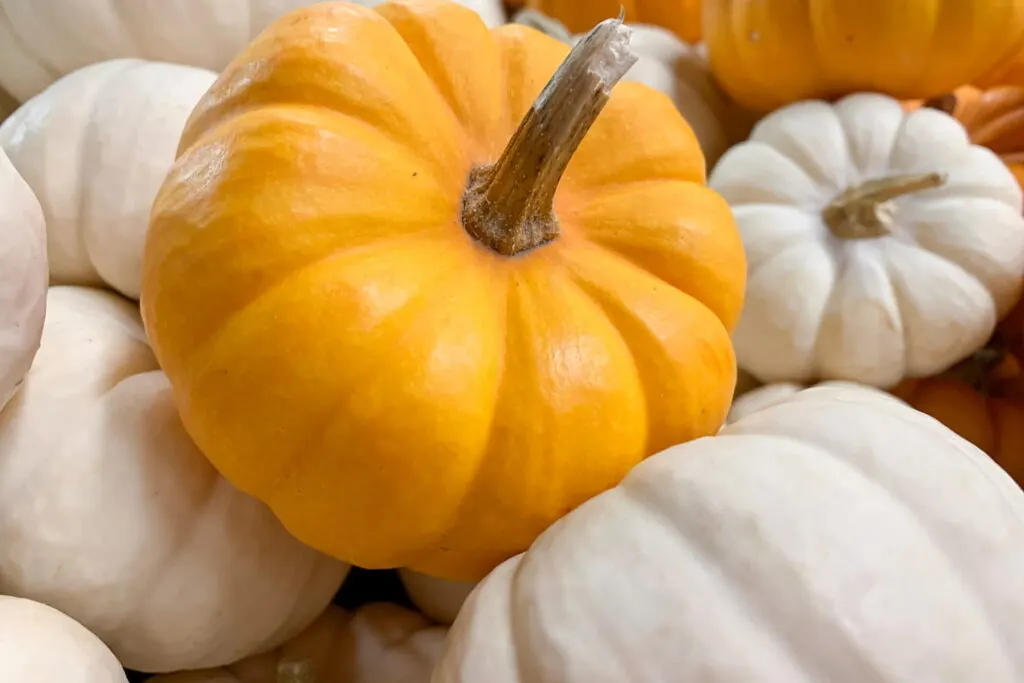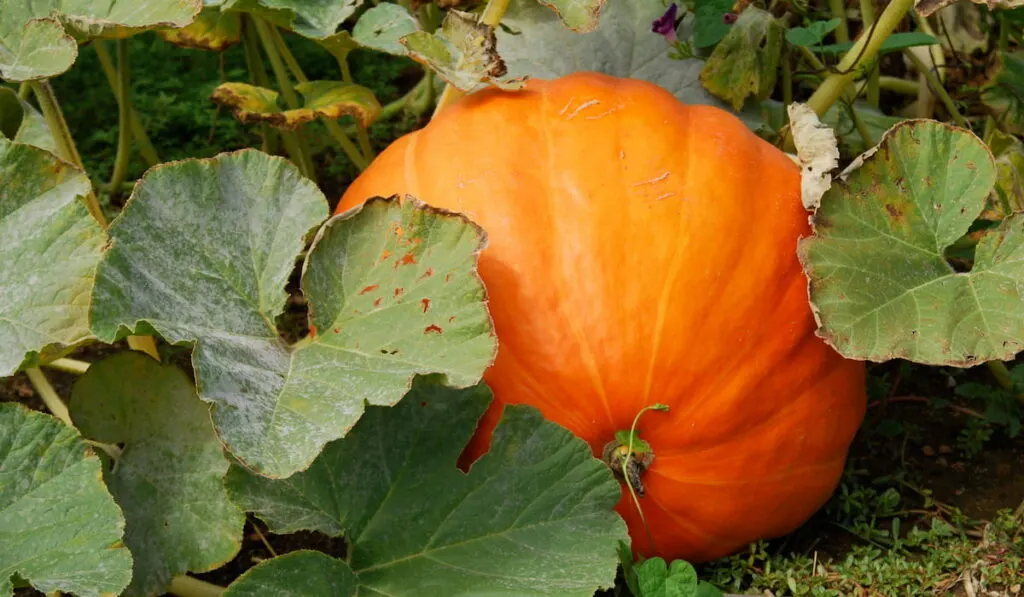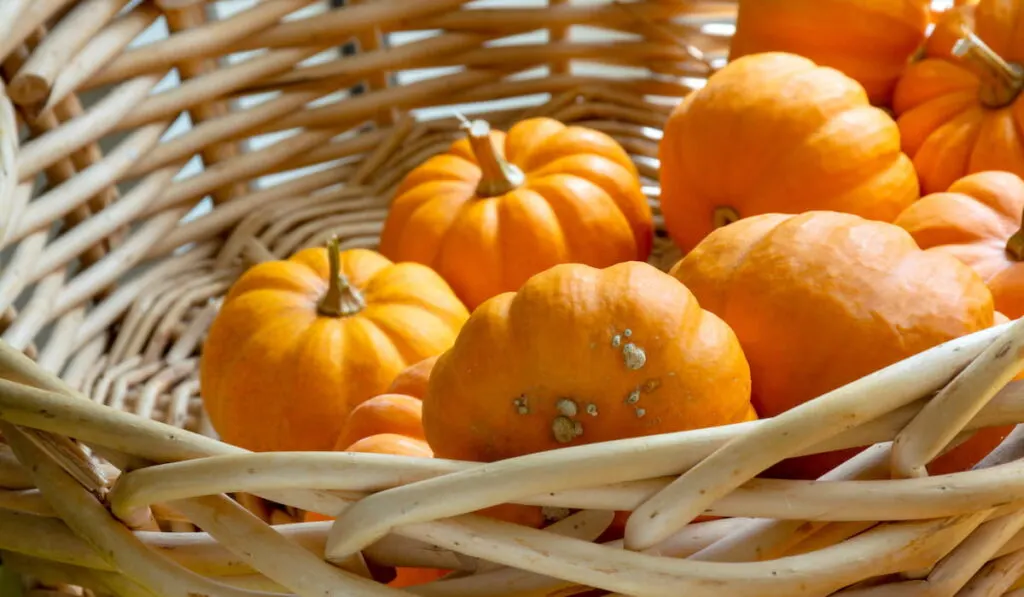Pumpkins are a family of squash. Most pumpkins are native to South America and Mexico. They are mostly seen in the fall season. Whenever the name of this fruit pops up, we get a mental image of an orange fruit.
However, pumpkins can be found in every size and color, with different textures, skin types, and even shapes. As they vary in size, their taste and purpose also vary accordingly.
Here we will discuss several types of orange pumpkins, their weight, nutritional value, and the health benefits provided by them.
Table of Contents
1. Pam Pumpkins
Pam pumpkin is a bright orange fruit with a brown-colored stem. Its cream-colored, moist flesh has such a velvety texture that produces delicious pies. This orange fruit is considered the best breed in the market because of its perfectly appropriate size and grain-less texture.
It also solves the problems of many gardeners who own small gardens because it provides a high yield in limited space. Its fiberless flesh allows it to make the best pies, puddings, and tarts in town.
Its versatility permits you to cook it with other ingredients like chicken, pork, sausages, mustard, etc.
Where to find them
This orange variety was founded in Central America and then taken to other parts of the world. As their demand grew, corporations had to produce more of them. Now you can find them anywhere in the markets, stores, and on online platforms in the USA and Canada.
Nutritional Value
There are many pumpkin varieties that provide high nutritional value which makes your system so strong and sturdy.
Pam pumpkins contain fiber and potassium. They are also rich in vitamins A, C, and E, iron, magnesium, and copper. The fiber in pam fruit helps in maintaining your sugar level and hunger. Potassium regulates your heartbeat.
Weight
They are medium in size and their diameter is 6-7 inches. Their weight ranges from 4 to 5 pounds.
Prices of pumpkins vary according to their size. Pam pumpkins cost around $7.95 to $18.00 according to the number of seeds they have.
2. Styrian Pumpkins

Styrian pumpkins have a plain and unwrinkled beautiful orange skin, with green ridges from stem to bottom. Its pale-yellow flesh surrounds the space full of seeds entangled by orange pulp. Its seeds are special because its flesh does not taste as good.
Their seeds are processed to get oil. Instead of wasting its flesh, you can roast it to savor with bread. Its pulp is also good for puree, salads, soups, and stew. Their pies might taste a bit bitter.
You can boost the taste of other vegetables like turnip, sweet potatoes by cooking them in their seed oil. Untouched pumpkin can stay edible for six months. If you cut it, preserve it in the refrigerator.
Where to Find Them
It was founded in Mexico in 700BC and back then it was a significant part of their diet. Many explorers who came to Europe, brought this breed with them. It is popular in Austria, where people love cooking their food in its seed oil.
People of Europe and Australia are lucky enough to have it in their country. You can find them in international markets and online stores. If you do not intend to buy it, you can grow it in your own garden.
Cost
They might cost you around $19.
Weight
Their weight ranges from medium to large and they weigh 6-10 pounds because of their 8-12 inch diameter.
Nutritional Value
It is rich in vitamins and minerals, including vitamin A, vitamin B, and vitamin C which play a significant role in strengthening your bones and healing wounds. It also has zinc, magnesium, iron, phosphorus, potassium, copper, and selenium. Selenium helps the body in producing antioxidants enzymes that are necessary to prevent cell damage, and beta-carotene, as well as prominent levels of both fat-soluble and water-soluble antioxidants whose primary function is to repair cells.
3. Wee Bee Plain Pumpkins

Wee Bee Plain is a beautiful fruit with dark orange color. They are like a baby of other pumpkins; they are round, orange, and have flat bottoms just like other pumpkins. Along with pies, they also show you a wonderful time when you cook them with other vegetables.
Their seeds make a great snack for any occasion. These mini pumpkins are a favorite among kids because it is so easy to paint them. You may prefer to not grow them in your garden if the space is limited. Those who own big farms should grow them in mounds at a distance of eight inches. Pluck them when their skin is hard and orange.
Where to Find Them
Wee Bee Pumpkins are indigenous to America while also popular in India.
Cost
They may cost you $2-$5 according to the weight.
Weight
Their diameter is 3-4 inches and their weight ranges from 8 to 16 ounces.
Nutritional Value
It is rich in beta-carotene, which the body transforms into vitamin A. Vitamin A plays a primary role in keeping your vision sharp. It also maintains cell growth and the health of organs like the kidney, heart, and lungs.
4. Orange Buttercup Pumpkins
This orange pumpkin has rough skin with a flat bottom and brown stem. These pumpkins have a cap-like thing on the top and they vary in size. It has fibrous pulp and grainy flesh which surrounds seeds in the middle space of the fruit. Their taste resembles a lot with yams.
Orange buttercup was bred to produce more delicious fruit. Green gold and Kindred are two of their types. They are not very easy to find in markets or other places. They have an excellent taste and also a lovely fragrance to them.
Where to Find Them
It was founded at Dakota State University and can be found in markets in the U.S.
Cost
They will cost you around $3.
Weight
Their weight ranges from medium to large.
Nutritional value
They contain fiber, vitamins A and C. They also have beta-carotene and calcium. These minerals play a significant role in maintaining the structure of bones and teeth by keeping them sturdy and strong.
5. Winter Luxury Pumpkins

Winter Luxury is a high-quality pumpkin because of its velvety texture. This is a round-shaped, orange fruit, liked by many people around the world. Its smooth skin makes it stand out in farmer’s markets and in the garden. It doesn’t have the longest shelf life, so if you buy it try to make pie before it goes bad.
Where to Find Them
Johnson & Stokes of Philadelphia found Winter Luxury. It is famous in Pennsylvania. You can find them in farmer’s markets, online stores, and other marketplaces.
Cost
They will cost you around $4 to $10.00
Weight
It weighs almost 6 pounds and is a perfect size to make a pie for two.
Nutritional Value
It is rich in vitamins and fiber. It is an ideal food for patients with blood pressure issues. The fiber in Winter Luxury pumpkins can help maintain the digestive system. One cup of puree is a healthy addition to the diet for people of 50+ age.
6. Big Mac Pumpkin

As the name suggests, Big Mac pumpkins are giant-sized pumpkins with an orange rind. They are specifically popular because of their size and decorative qualities. Their sole purpose to be grown is for exhibition. They are edible and make a nice puree.
However, people prefer not to cook them because they are hard to cut due to their rough and hard skin. Their hard rind makes them the best keepers; you can store them for a long time.
They are not pure pumpkins but more like squash pumpkins because they were produced from a different breed.
Where to Find Them
Big Mac pumpkins were produced in Asia and South America. However, they have made their way to Europe as well. Today they are available in the markets of Canada, the United States, and Europe.
Cost
They might cost you around $5.00.
Weight
Big Mac pumpkins are quite a giant breed. Their average size is 17-20 inches in diameter and they can weigh from 50 to 200 pounds.
Nutritional Value
Big Mac pumpkins contain vitamin A and beta-carotene. Some other nutrition includes magnesium, potassium, and some antioxidants. Magnesium in pumpkins carries out more than three hundred reactions. It plays a chief role in maintaining heartbeat, and glucose levels. It is also a great source of energy and protein.
7. Mini Pumpkin

As the name suggests, mini pumpkins are exceedingly small and have smooth dark orange rinds with deep ridges on them.
They are good for kitchen use; you can make soups, pies, and many other dishes. They are easy to peel and cook because their rind is not very hard. They are also a cool choice for table decorations.
Kids find them attractive because of their small size; it is easier for them to hold and paint these fruits.
Where to Find Them
Nobody is familiar with the origin of mini pumpkins. However, they are quite popular in Europe, Asia, Australia, North America, and Central America.
Cost
Their price ranges from $3-$50.
Weight
Mini pumpkins are small in size, averaging 3 inches in diameter and weighing six ounces to two pounds,
Nutritional value
Mini pumpkins contain some beta-carotene, vitamins A, C, and E, iron, potassium, and magnesium. All these minerals play an especially important part in keeping the human body in check. They are healthy especially for patients with diabetes and blood pressure issues.
Some other Health Benefits of Pumpkins
People often think of pumpkins as decoration pieces or fruit to bake pies. However, pumpkins are more than that. They are rich in many minerals and vitamins that provide you with amazing health benefits.
Following are some of the health benefits you can get from pumpkins.
Weight Loss
Pumpkin can be a major source of weight loss. Even canned or sugar pumpkins can help you lose weight. The reason for that is that they tend to keep you full the entire day. The fiber in pumpkins slows the digestion process which suppresses your appetite. One cup of pumpkin can lead you to gain more fiber than two slices of bread.
That might sound like a lot of fiber; however, pumpkins have low calories which will help you stay slim without suffering from hunger pangs.
People who are on diet can easily make it a part of their diet. It will help them lose weight while staying healthy at the same time.
Sharp Vision

Pumpkin provides many health benefits including sharp vision. If you add pumpkin to your daily diet, your eyesight could improve a lot. Beta carotene in pumpkins turns into vitamin A which is very important to keep your eyesight sharp.
It is recommended by many eye specialists that if you feel a little blur in your sight, include pumpkin in your diet. Antioxidants in this fruit help you keep cataracts away and decrease the progress of macular degeneration.
Better Immunity
Immunity becomes very strong with the use of pumpkins. Including pumpkins in your diet could help you fight many diseases. For instance, viruses and infections. Bacterial and fungal infections can be cured by using pumpkin seed oil. Vitamin C in this fruit can help you recover from the flu in a brief time.
It also helps in the production of white blood cells which make your wounds heal more quickly. They make your immunity so strong that even chronic diseases of the heart can be avoided by its use.
Vitamin E, iron, and Folate in the fruit also play their part in boosting immunity.
Glowy Skin
If you want clear, younger-looking skin, make pumpkin an essential part of your diet. Vitamin C in pumpkins helps in reversing UV damage and improves skin texture so much. This fruit also produces collagen which helps in brightening skin complexion and increasing elasticity.
You can also use it externally in the form of masks. Its puree makes the best masks for the skin.
Prevention of Chronic Diseases (Cancer and Diabetes)
Beta carotene in pumpkins can lead you to lower the risks of cancer, especially lung cancer. Vitamin A and C act as a shield against diseases like cancer or heart problems.
Pumpkin also decreases blood glucose levels. It is a source of production of insulin in the blood, which lowers the risk of diabetes.
Bottom Line
Pumpkin is an extremely versatile fruit. You can use it for any purpose including decoration, cooking, baking, and many health benefits.
All kinds of orange pumpkins are found in the fall season and throughout winter. Bringing pumpkins to any household will add taste and beauty to it.
